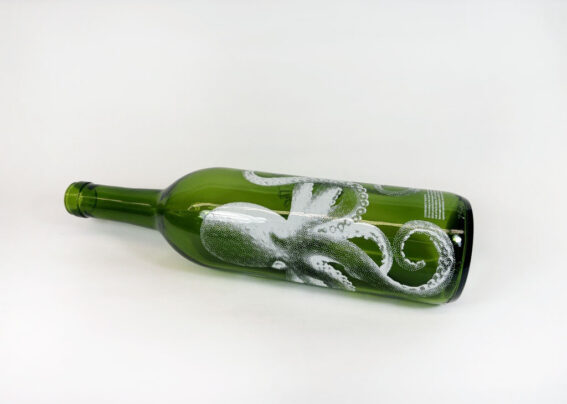- Equipment
- Inks & Supplies
- Services
- Applications
- Tagless
- Resources
- About Us
- Contact Us

Did you know that fine wine can last anywhere from 10 to 20 years if stored properly? Here is another question to ponder: will your printed label on a wine bottle endure that same duration? As wine ages gracefully in cellars, its label should stand the test of time. After all, it’s not just about preserving the wine; it’s about preserving your brand identity too.
Tip for Wine Storage: Before we delve into the evolution of wine bottle labeling, let’s start with a pro tip: always store your wine in a cool, dark location, ideally tipped to its side to prevent the cork from drying out prematurely. This ensures your wine stays in prime condition, ready to be uncorked and enjoyed when the time is right.
Labels on wine bottles have a rich history dating back to as early as 1550 BC, with their origins traced to ancient Egypt. Initially serving to identify the wine’s vintage, type, and quality, these early “labels” took the form of seals and etched drawings. Fast forward to modern times, where paper labels dominate the landscape. But in the ever-evolving world of technology, there’s a new frontier emerging: digital decoration on wine bottles, offering a fresh take on aesthetic enhancement.
As we explore the intersection of tradition and innovation in wine bottle printing, let’s uncover how digital advancements are reshaping the way we adorn and brand our beloved bottles of wine.
According to the Alcohol and Tobacco Tax and Trade Bureau (TTB), specific requirements dictate what information must appear on a wine bottle. For wines, ciders, and meads sold in the US, certain mandatory details are essential. The brand label necessitates inclusion of the appellation of origin, brand name, class or type designation, and the percentage of foreign wine. Additionally, any label on the bottle must display the alcohol content, color ingredient disclosure, country of origin, health warning statement, name and address, net contents, and sulfite declaration. Optional but beneficial information may encompass major food allergen labeling, gluten content statements, and serving facts.
Wine bottle decoration, akin to the meticulous regulations outlined by the Alcohol and Tobacco Tax and Trade Bureau (TTB) governing label contents, offers a wide realm for creative expression. Just as the TTB mandates precise details for labels on wines, ciders, and meads sold in the US, the artistry of bottle decoration demands careful attention to branding essentials. Logos, typography, and color schemes serve as the cornerstone for establishing a compelling visual identity and fostering enduring brand recognition. The inclusion of mascots or emblematic symbols infuses each bottle with its own unique character, forging an indelible bond with consumers. Echoing the TTB’s standards, decorative motifs may delve into the rich tapestry of heritage, invoking tradition and craftsmanship that resonate with discerning enthusiasts. Furthermore, thematic designs inspired by a wine’s origin, terroir, or winemaking ethos imbue each bottle with a sense of place and authenticity, elevating the consumer experience to new heights of engagement and delight.
Let’s take a moment to consider the relationship between the label of a wine bottle and the quality of its contents. Begin by selecting a fine bottle of wine. As you hold it, examine the label closely. Reflect on the perceived value conveyed by the label and how it corresponds to the actual quality of the wine inside.
Next, pour yourself a glass of the wine and indulge your senses. Assess whether the taste and quality match the expectations set by the packaging. This exercise prompts us to ponder the alignment between a wine’s outward presentation and its inner essence.
In the realm of wine packaging, digital UV printing offers an opportunity to elevate the experience. By ensuring that the contents of the wine bottle harmonize with its exterior, we enhance the overall presentation and integrity of the product.
As you explore the world of wine, remember to consider not only the label but also the contents within. By doing so, you’ll gain a deeper appreciation for the craftsmanship and artistry behind every bottle
In recent years, Digital UV Printing has surged in popularity, propelled by its minimal waste, rapid curing time, and exceptional high-quality outcomes. Specifically designed for both slightly tapered and straight-walled vessels, cylindrical inkjet printers stand out in embellishing wine bottles. Several crucial factors contribute to successful digital printing on wine bottles, notably the pre-treatment process, which guarantees optimal adhesion for the ink.
Helix ONE®
The Helix ONE® is a compact cylindrical inkjet printer tailored for companies venturing into drinkware printing or seeking dedicated machinery per SKU. Its segmented UV curing unit ensures the creation of sharp digital prints, particularly with the LV UV Ink Series. From wine bottles to various drinkware, the Helix ONE® expertly decorates a diverse range of products.
Helix®
Engineered for superior quality, the Helix® digital cylinder printer delivers full-color (CMYKWW + varnish) images on both straight-walled and tapered cylinders. Swift and adaptable, this printer finds its niche across drinkware, barware, candle, and industrial printing sectors.
Helix®+ and Double Helix®
The Double Helix® cylindrical printer doubles production volume with two print fixtures, making it ideal for medium to high-volume industries like drinkware, barware, spirits, craft brewing (including cans and bottles), candles, and more. Capable of simultaneous printing of identical parts, the Helix®+ offers field upgradability, initially as a single tunnel and transitioning to a double tunnel machine.
Back to Blog Home
Notifications
Add Your Comment